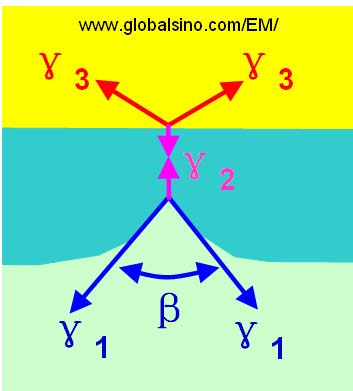=================================================================================
As an example, Figure 1722 shows the schematic illustration of the surface and interfacial energies of the TiSi2/Si system. Morphological degradation of TiSi2 often referred to as agglomeration occurs as the TiSi2/Si system attempts to lower the overall energy of the system. If sufficient thermal energy is provided, silicon atoms diffuse through the silicide film and epitaxially precipitates out at grain boundaries, the silicide grains tend to spheroidize, and thus the film becomes discontinuous. The thermal stability of the system is in principle determined by the surface energy, interfacial energy, grain size, and film thickness. This problem particularly occurs in narrow lines that is less than or approximately the same dimension as the grain size.

Figure 1722. Schematic illustration of the surface and interfacial energies of the TiSi2/Si system.
Following Mullins [1, 2], Van den hove [3] suggested using the grain boundary grooving model to describe the thermal instability of TiSi2 films. In this model, the groove depth, d, is expressed as,
 -------------- [1722] -------------- [1722]
where,
β -- The groove angle (See Figure 1722),
DSi -- The diffusivity of Si
in TiSi2,
γS -- The silicide/silicon interface energy,
Ω -- The atomic
volume of silicon,
C0 -- The equilibrium concentration of
silicon in TiSi2,
n -- The integers: 3 for bulk diffusion or 4 for interface
diffusion,
t = time,
T = temperature,
k --
Boltzmann’s constant.
When d becomes equivalent to the film thickness, the silicide becomes discontinuous. Because the grain-boundary grooving mechanism includes silicon diffusion through the silicide, the use of a nitrogen atmosphere during thermal annealing is essential in preventing this agglomeration failure mechanism.
[1] W. W. Mullins, “Theory of Thermal Grooving,” J. Appl.
Phys. 28, 333-339 (1957).
[2] W. W. Mullins, “Grain Boundary Grooving by Volume Diffusion,” Trans. Metall. SOC. 218, 354-361 (1960).
[3] L. Van den hove, “Advanced Interconnection and Contact
Schemes Based on TiSi, and CoSi,: Relevant Materials
Issues and Technological Implementation,” Ph.D. Thesis,
Katholieke Universiteit Leuven, Leuven, Belgium, 1988..
|

 -------------- [1722]
-------------- [1722]